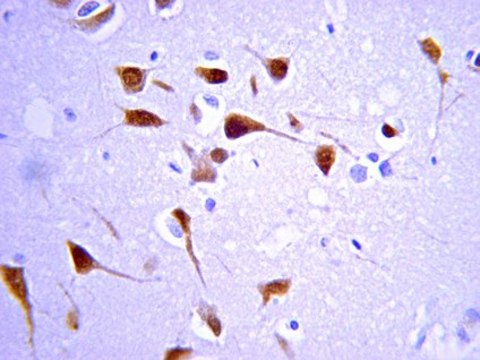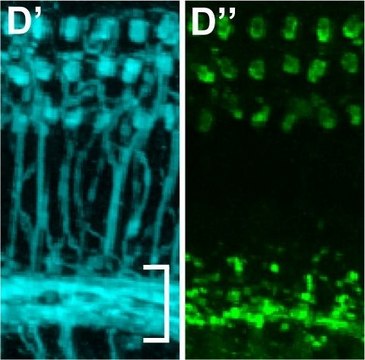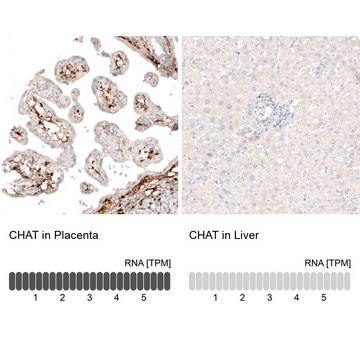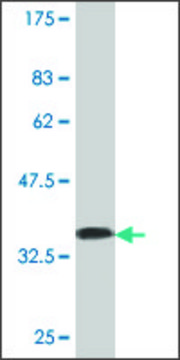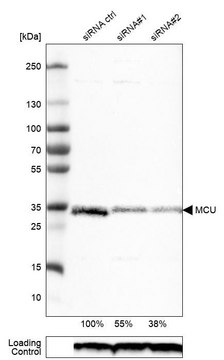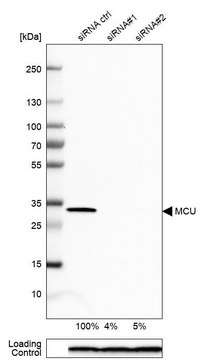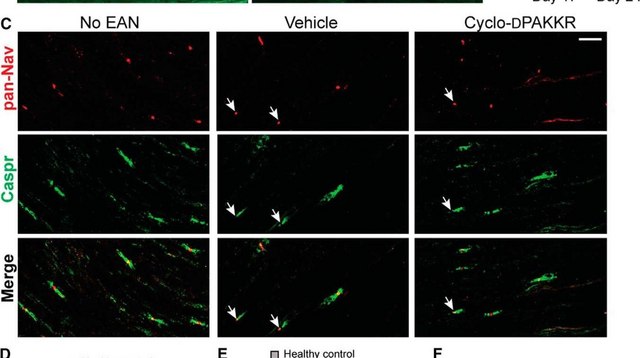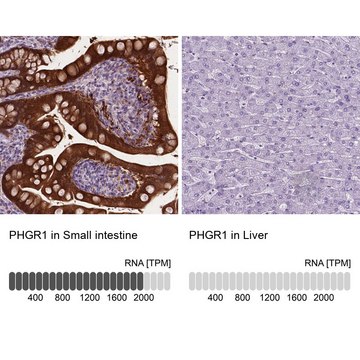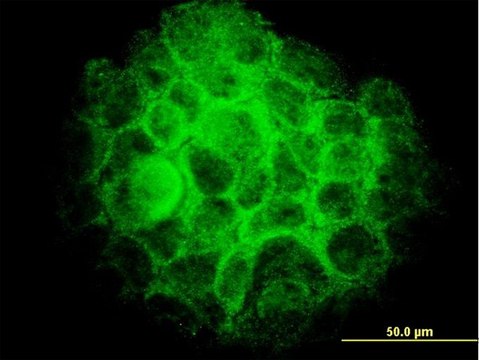WH0057348M4
Monoclonal Anti-TTYH1 antibody produced in mouse
clone 4A9, purified immunoglobulin, buffered aqueous solution
Sign Into View Organizational & Contract Pricing
All Photos(2)
Synonym(s):
Anti-tweety homolog 1 (Drosophila)
UNSPSC Code:
12352203
NACRES:
NA.41
Recommended Products
biological source
mouse
Quality Level
conjugate
unconjugated
antibody form
purified immunoglobulin
antibody product type
primary antibodies
clone
4A9, monoclonal
form
buffered aqueous solution
species reactivity
human
technique(s)
indirect ELISA: suitable
western blot: 1-5 μg/mL
isotype
IgG2aκ
GenBank accession no.
UniProt accession no.
shipped in
dry ice
storage temp.
−20°C
target post-translational modification
unmodified
Gene Information
human ... TTYH1(57348)
General description
This gene encodes a member of the tweety family of proteins. Members of this family function as chloride anion channels. The encoded protein functions as a calcium(2+)-independent, volume-sensitive large conductance chloride(-) channel. Two transcript variants encoding distinct isoforms have been identified for this gene. (provided by RefSeq)
Immunogen
TTYH1 (NP_065710, 261 a.a. ~ 360 a.a) partial recombinant protein with GST tag. MW of the GST tag alone is 26 KDa.
Sequence
MGLEAATAVGLSDFCSNPDPYVLNLTQEETGLSSDILSYYLLCNRAVSNPFQQRLTLSQRALANIHSQLLGLEREAVPQFPSAQKPLLSLEETLNVTEGN
Sequence
MGLEAATAVGLSDFCSNPDPYVLNLTQEETGLSSDILSYYLLCNRAVSNPFQQRLTLSQRALANIHSQLLGLEREAVPQFPSAQKPLLSLEETLNVTEGN
Biochem/physiol Actions
The gene TTYH1 (tweety homolog 1) encodes a protein that functions as a chloride channel. It may be involved in early embryonic development. It is suggested to function in cell process formation and cell adhesion. Its expression in brain is found to be increased during epileptogenesis and epilepsy, indicating its involvement in brain pathology.
Physical form
Solution in phosphate buffered saline, pH 7.4
Legal Information
GenBank is a registered trademark of United States Department of Health and Human Services
Disclaimer
Unless otherwise stated in our catalog or other company documentation accompanying the product(s), our products are intended for research use only and are not to be used for any other purpose, which includes but is not limited to, unauthorized commercial uses, in vitro diagnostic uses, ex vivo or in vivo therapeutic uses or any type of consumption or application to humans or animals.
WGK
nwg
Flash Point(F)
Not applicable
Flash Point(C)
Not applicable
Personal Protective Equipment
dust mask type N95 (US), Eyeshields, Gloves
Regulatory Information
常规特殊物品
Certificates of Analysis (COA)
Search for Certificates of Analysis (COA) by entering the products Lot/Batch Number. Lot and Batch Numbers can be found on a product’s label following the words ‘Lot’ or ‘Batch’.
Already Own This Product?
Find documentation for the products that you have recently purchased in the Document Library.
Expression of Ttyh1, a member of the Tweety family in neurons in vitro and in vivo and its potential role in brain pathology.
Stefaniuk M
Journal of Neurochemistry, 115, 1183-1194 (2010)
Marzena Stefaniuk et al.
Journal of neurochemistry, 115(5), 1183-1194 (2010-09-30)
We have previously shown that Ttyh1 mRNA is expressed in neurons and its expression is up-regulated in the brain during epileptogenesis and epilepsy. In this study, we aimed to elucidate the role of Ttyh1 in neurons. We found widespread expression
Malgorzata Gorniak-Walas et al.
Neurochemical research, 46(9), 2463-2472 (2021-06-27)
Tweety-homolog 1 protein (Ttyh1) is abundantly expressed in neurons in the healthy brain, and its expression is induced under pathological conditions. In hippocampal neurons in vitro, Ttyh1 was implicated in the regulation of primary neuron morphology. However, the mechanisms that
Juwan Kim et al.
EMBO reports, 19(11) (2018-09-05)
Despite growing evidence linking Drosophila melanogaster tweety-homologue 1 (Ttyh1) to normal mammalian brain development and cell proliferation, its exact role has not yet been determined. Here, we show that Ttyh1 is required for the maintenance of neural stem cell (NSC)
Elzbieta Wiernasz et al.
Neurochemical research, 39(12), 2516-2526 (2014-10-16)
In a previous study, we showed that Ttyh1 protein is expressed in neurons in vitro and in vivo in the form of punctuate structures, which are localized to neuropil and neuronal somata. Herein, we provide the first description of Ttyh1
Our team of scientists has experience in all areas of research including Life Science, Material Science, Chemical Synthesis, Chromatography, Analytical and many others.
Contact Technical Service